HHMI Funds Superbend Beamlines at Advanced Light Source
 |
|
"The Hughes Institute is pleased to be teaming up with the Lawrence Berkeley National Laboratory," said HHMI president Thomas R. Cech. "The need for more such state-of-the-art facilities is growing because of the unsurpassed power of x-ray crystallography. The detailed 3-D views of biomedically important molecules that this technique yields provide a powerful framework for understanding how molecules function and interact." Said Berkeley Lab director Charles Shank, "this is the single largest investment in the ALS ever made by an organization outside of DOE. It reflects the growing importance of x-ray crystallography as a critical tool for the biomedical research community and recognizes the success and promise of the ALS in identifying and characterizing proteins."
As the Human Genome Project approaches completion, the next big steps are to identify the proteins that human DNA codes for and find out what those proteins do. The key to understanding a protein's function is to determine its three-dimensional structure, and x-ray crystallography -using a synchrotron light source like the ALS-is one of the main techniques for accomplishing this. In x-ray crystallography, a beam of x-rays sent through a protein crystal creates a set of diffraction patterns that can be translated by a computer into 3-D images with atomic-scale resolution.
The ALS houses one of the top experimental facilities in the world for determining protein crystal structures -the Macromolecular Crystallography Facility. Under the leadership of biophysicist and crystallographer Thomas Earnest of the Physical Biosciences Division (PBD), the MCF offers three separate beamlines powered by a multipole "wiggler," a magnetic device that can provide x-rays as high in energy as 14,000 electron volts (14 keV).
The new "superbends," scheduled for installation in 2001, will be superconducting magnets that steer the path of an accelerated beam of electrons around sharper turns than the conventional bend magnets now deployed. The tighter curvature of the bends will cause the electrons to emit hard x-rays as opposed to the lower energy "soft x-rays" extracted from current ALS bend magnets. It is anticipated that the superbends will yield x-rays as high as 50 keV in energy.
Demand for time on the MCF beamlines is so high now that barely 35 percent of all requests can be filled. With the continuing accumulation of new genetic data, this demand can only be expected to grow. The addition of these two new superbend beamlines to the complement of beamlines at the MCF will help.
"When these superbend beamlines are completed, HHMI researchers will have 75 percent of the available beamtime, but the remaining beamtime will be open to all qualified users," says Earnest.
HHMI, which was founded in 1953, is one of the world's largest philanthropies. It conducts biomedical research in its laboratories located across the United States at academic medical centers, universities and other scientific institutions. HHMI's investigators include many of the world's leaders in the fields of cell biology, genetics, immunology, neuroscience, and structural biology.
Headquartered just outside of Washington, D.C., HHMI also runs a grants program that supports science education at every level in the United States, as well as the research of selected biomedical scientists in other countries.
"The
outstanding technical capabilities of the ALS and other Berkeley Lab facilities
will be of increasing value to biologists as the full impact of the Human
Genome Project becomes clear," says PBD director Graham Fleming. "The
partnership between HHMI and Berkeley Lab in the construction of the new
crystallography beamlines is a marvelous beginning in facilitating the
multidisciplinary interactions that will shape the biology of the 21st
Century."
-
end -
| < Research Review | Top ^ | Next > |